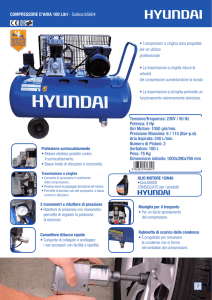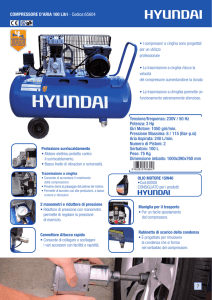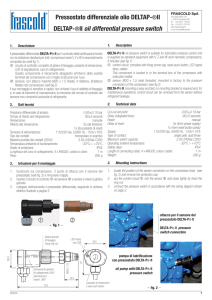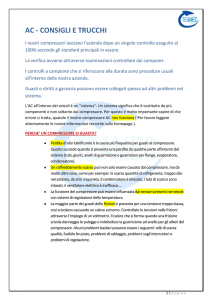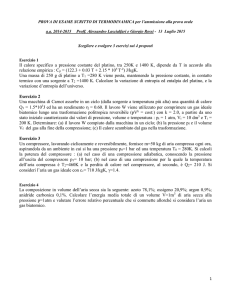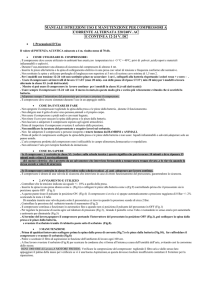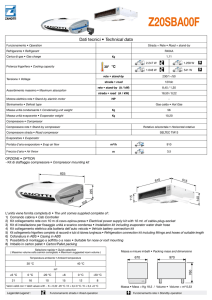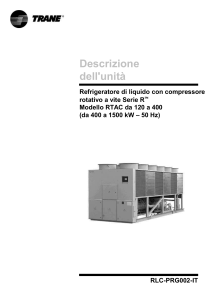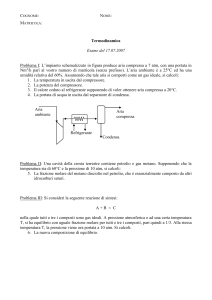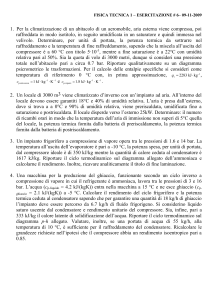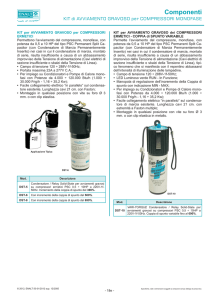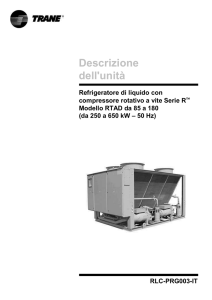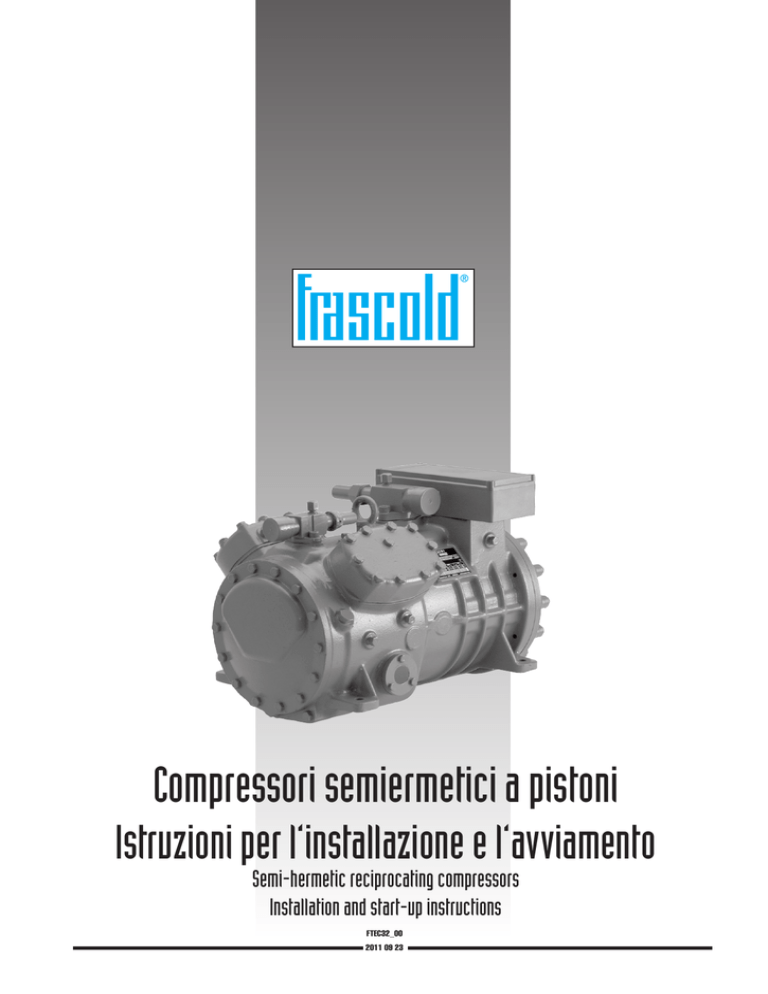
Compressori semiermetici a pistoni
Istruzioni per l’installazione e l’avviamento
Semi-hermetic reciprocating compressors
Installation and start-up instructions
FTEC32_OO
2011 09 23
Indice
Index
1. Disimballo e movimentazione
2. Criteri di sicurezza
3. Ambito applicativo
4. Installazione
5. Collegamenti elettrici
6. Avviamento
7. Funzionamento / Manutenzione
8. Messa fuori servizio
9. Sistemi con compressore bistadio
10.Certificato test report
1. Unpacking and handling
2. Safety
3. Application ranges
4. Mounting
5. Electrical connection
6. Commissioning
7. Operation / Maintenance
8. Decommissioning
9. Systems with two stage compressors
10.Test report certificate
FTEC32_00
LEGENDA INFORMAZIONI TESTUALI
RECOGNISING TEXT INFORMATION
Avviso generale o misura cautelare da
osservare scrupolosamente. Pericolo grave.
General warning or cautionary measure to be
observed. Serious hazard.
Pericolo di folgoramento
Electrocution hazard
Pericolo di ustioni
Burn injury hazard
Manovra o azione proibita
Forbidden maneuver or action
• FRASCOLD SpA si riserva il diritto di modificare
i dati e le caratteristiche contenute nel presente
catalogo, senza obbligo di preavviso.
FRASCOLD SpA reserves the right to change at
any time specifications or design without notice
and without incurring obligations.
Ref: FTEC32-00
Edizione: Settembre 2011
Realizzazione: FRASCOLD SpA
2
1.Disimballo e movimentazione
1.Unpacking and handling
Quando il compressore raggiunge il vostro magazzino,
ispezionate l’imballo per identificare ogni eventuale danno e
assicurarsi che sia giunto in buone condizioni.
Nel caso che il contenuto sia danneggiato, contattate il vostro
trasportatore immediatamente inviate una raccomandata,
richiedete il rimborso dei danni, e copia per conoscenza a
Frascold.
Di seguito, controllate il contenuto dell’imballo, verificando che
il contenuto corrisponda con quanto riportato sul packing list.
Se qualcosa non corrisponde, contattate Frascold o il vostro
distributore locale .
When the compressor reaches your warehouse, inspect the
packing for any visible damage and make sure it is in good
condition.
In the event you detect any damage, please contact your
forwarder immediately: send a registered letter to the shipping
company claiming the suffered damage, a copy of which should
be sent to Frascold.
Next, check the contents of the packing against the packing
list. Contact Frascold or the local distributor/agent immediately
if any item is missing.
Per evitare l’ingresso di umidità, aria o impurità, il compressore
è stato caricato con azoto, prima di lasciare il nostro magazzino.
Vi preghiamo di accertare che il compressore
contenga azoto in pressione subito dopo averlo
disimballato, premendone leggermente una valvola
schräder.
In order to prevent penetration of moisture, air or impurities, the
compressor has been charged with nitrogen before shipment
from our warehouse.
Please make sure the compressor still contains
pressurized nitrogen when unloaded from the truck
or taken out the crate, by slightly depressing any
schräder valve.
FTEC32_00
3/4
1/4
livello olio - oil level
Rubinetti - coppia di serraggio delle viti
dimensioni della vite
M8
serraggio Nm 32
M10
48
M12
64
Valves - bolt tightening torque
bolt dimensions
M8
tightening torque Nm 32
M16
112
M10
48
M12
64
M16
112
Non depressurizzate mai completamente il compressore,
mantenetelo in pressione di azoto per quanto più a lungo
possibile, anche durante il montaggio.
Verificare che il livello dell’olio sia tra 1/4 e i 3/4 della spia.
Never depressurise the compressor completely, and keep it
under nitrogen pressure for as long as possible, even during
the assembly.
Verify that the oil level is between 1/4 and 3/4 of the sight glass
Non scaricate mai l’azoto con violenza. Sebbene la
pressione di azoto sia abbastanza bassa, un soffio
violento può dar luogo a reazioni inconsulte di paura,
e causare lesioni a occhi e pelle. Indossate sempre
gli occhiali di protezione.
Never discharge nitrogen abruptly. Although the
charged nitrogen pressure is low, a sudden burst of
nitrogen may cause panic or uncontrolled reactions,
and injury to eyes or skin. Always wear safety
goggles.
Non caricate nient’altro che azoto di tipo OFN (privo
di ossigeno). Non usate mai ossigeno o idrocarburi
che sono infiammabili o esplosivi. Il mancato rispetto
di questa prescrizione può cagionare esplosioni,
lesioni o la morte.
Nel vostro Paese potrebbe essere vietato dalla Legge
pressurizzare con CFC.
Never charge the compressor with anything else then
OFN (oxygen free Nitrogen). Never use oxygen or
hydrocarbons which are flammable or explosive.
Failure to comply may result in risk of explosion,
injury or death.
Do not pressurise with CFCs either, as this may be
forbidden or unlawful in your country.
Usate sempre catene di acciaio o trefoli e golfari di
sollevamento (oppure i punti di sollevamento
predisposti nella ghisa, se disponibili).
Use steel chains or steel ropes and eye bolts (or
cast-iron lifting points, where available) to lift the
compressor.
3
Each chain should be capable to bear a weight of at least
twice the weight of the compressor.
If steel chains or ropes are not available, textile ropes can be
used, provided each is capable to bear a weight at least four
times the weight of the compressor.
Chains, textile and steel ropes must have shackles (with
closed ends).
If shackles are not available, than the ropes must pass under
the motor.
Assicuratevi che la fune, trefolo o catena non tocchi
valvole solenoidi, capillari dell’olio, resistenza
dell’olio, sensore di temperatura, terminali elettrici,
etc. per evitare ogni possibile danno.
Make sure that the steel chain does not touch the
solenoid valves, oil capillaries, oil heaters, temperature
sensors or power terminals, etc. to prevent any
possible damage.
Non tentate di usare corde delle quali non conoscete
le caratteristiche di portata. I compressori sono
macchine molto pesanti che possono causare ferite
gravi o la morte in caso di caduta accidentale.
Do not attempt to use a rope without knowing its
loading capacity. Compressors are heavy machines
which may cause injury or death in the event of an
accidetal fall.
Evitate che la superficie verniciata del compressore
venga in contatto con le corde o funi durante il
sollevamento. Tenete il compressore orizzontale
durante tutta la durata del sollevamento.
Avoid the compressor surface to be scratched by
the rope while lifting the compressor.
Keep the compressor horizontally while lifting.
FTEC32_00
Ogni catena deve essere capace di sollevare un peso non
inferiore a due volte il peso del compressore.
Se non sono disponibili catene di acciaio o trefoli, possono
essere usate anche funi, a patto che siano in grado di sollevare
non meno di 4 volte il peso del compressore.
Funi, trefoli o catene devono avere i moschettoni (estremità
chiuse).
Se i moschettoni non sono disponibili, allora si deve provvedere
a far passare la fune o catena al di sotto del compressore,
sotto il motore.
2.Sicurezza
2.Safety
I compressori della Frascold sono costruiti e destinati in
macchine o quasi macchine, in accordo a quanto prescritto
dalla Direttiva Macchine 2006/42/CE e legislazione seguente.
Possono essere messi in funzione solo se sono stati osservati
i corrispondenti obblighi di legge.
La dichiarazione del Costruttore, che può essere scaricata
dal sito internet aziendale, dichiara che i compressori
Semiermetici sono sicuri, laddove e quando questo manuale
venga strettamente seguito.
Frascold’s compressors are built for and destined to machines
or partly completed machines, according to the EC Machine
Directive 2006/42/CE and following applicable legislation.
They may be put in operation only if the corresponding
provisions have been followed by.
The Manufacturer Declaration, that can be downloaded from
Frascold’s website, declares that Semihermetic compressors
are safe, wherever and whenever these safety instructions and
user manual is strictly followed.
Questo manuale deve sempre accompagnare il
compressore con il quale è stato fornito, ed è
obbligatorio incorporare queste istruzioni nel
manuale dell’utente della macchina nella quale sarà
incorporato il compressore, con gli allegati schemi di principio
ed elettrici.
Qualsiasi operazione o manutenzione sul compressore o sul
sistema di refrigerazione, è necessaria che sia eseguita da
personale qualificato e preparato.
La manipolazione delle attrezzature di brasatura e di refrigeranti
HFC è sottoposta a precise norme di legge e deve essere
eseguita da personale in possesso dei certificati opportuni, ed
in piena abilità psicofisica.
This manual shall always accompany the compressor
to which it was supplied with, and it is compulsory
to integrally incorporate these instructions into the
user manual of the machines into which the
compressor is incorporated, together with the principle
schemes and wiring diagrams. Any operation on the
compressor and the refrigeration system shall be carried out
only by personnel which has been properly trained and
instructed. Handling of brazing equipment and HFCs
refrigerants is regulated by law and shall only be carried out
by personnel in possession with proper personal certification,
and in full psycho-physical capability.
4
The qualification and knowledge of the refrigeration personnel
must comply to the requirements in force in your country.
Particular emphasis has been placed on the users’ safety
which, together with sustainable development, energy
efficiency, and environmental awareness, form Frascold’s
Corporate Social Responsibility.
Rischi residui
Non è possibile eliminare completamente i rischi
associati con il funzionamento del compressore,
ed è quindi necessario che qualunque manovra o
manutenzione sia eseguita da personale esperto,
autorizzato e consapevole, che è tenuto ad osservare
ogni normativa pertinente la sicurezza, applicabile
nello specifico caso.
Residual hazards
It is not possible to completely eliminate all hazards
connected to the operation of the compressor.
It is therefore necessary that all maneuvers or
maintenance is carried on by expert, authorised
and aware personnel, who shall observe all
concerning safety measures, pertaining to the
specific application.
Il tubo di mandata può raggiungere i 120°C e
causare ustioni al contatto. Si raccomanda di apporre
le idonee segnalazioni di sicurezza per evitare il
contatto accidentale.
The discharge tube may reach 120°C and therefore
cause skin burns. It is recommended to display the
appropriate markings to avoid accidental contact.
Il compressore è pressurizzato tra 0.5 e 2 bar
sopra la pressione atmosferica; maneggiare con
attenzione, usare i dispositivi di protezione e non
aprire i rubinetti prima di averlo depressurizzato.
The compressor is under pressure (0.5-2 bar above
atmospheric pressure); incorrect handling may
cause injuries, wear safety devices and do not open
connections before pressure has been released.
3.Ambito applicativo
3.Application ranges
Fluidi refrigeranti autorizzati:
HFC e HCFC
Range di pressioni
30 bar max sulla mandata
20.5 bar sull’aspirazione
Limiti operativi
Vedere programma di selezione FSS,
scaricabile dal sito.
Temp. esterne massime e minime di utilizzo -30°C a +70°C
Temp. di immagazzinamento
-30°C a +60°C
(evitare la formazione di condensa)
Authorised refrigerants:
HFC and HCFC
Pressure ranges
30 bar max on high side 20.5 bar max on low side
Operating limits See selection program Frascold FSS, downloadable from the website.
Ambient temperature operation range -30°C to +70°C
Warehouse temperature range
-30°C to +60°C
(avoid moisture formation)
Tabella riassuntiva olio:
Oil table:
Refrig.
HFC + R22
R22
(a richiesta/on
request)
Compr.
A-B-D-F-Q-S
bistadio / two stage
V-Z-W
A-B-D-F-Q-S
V-Z-W
bistadio / two stage
Code/Codice
Viscosity/viscosità
Type/tipo
ACD32
32 cSt
POE
ACD68
FR32
FR68
PX4542
68 cSt
32 cSt
68 cSt
46 cSt
POE
Mineral
Mineral
Mineral
Any other use outside the above ranges, or with different
refrigerants and lubricants, must be authorised in advance by
Frascold in written form.
The usage at higher pressures than hereby specified
is a risk for health and safety and may cause death
or injuries and damage to properties.
Usage at lower evaporating pressures than
atmospheric may cause air and moisture to enter
the refrigeration circuit, in the event it is not air tight.
Ogni utilizzo al di fuori di questi ambiti, o con refrigeranti e oli
differenti, deve essere preventivamente autorizzato da Frascold
per iscritto.
L’utilizzo a pressione più elevate di quelle specificate
rappresenta un rischio per la salute, può cagionare
lesioni e morte, e può causare danni a cose.
L’utilizzo a pressione di evaporazione al di sotto di
quelle atmosferiche può causare l’aspirazione di aria
e umidità nel caso il circuito refrigerante non sia a
perfetta tenuta.
5
FTEC32_00
Le qualifiche richieste in merito alle conoscenze in ambito di
refrigerazione devono corrispondere a quanto richiesto dalle
rispettive normative nazionali in vigore nel paese di utilizzo.
Particolare attenzione è stata posta alla sicurezza degli utenti,
che assieme ad uno sviluppo sostenibile, efficienza energetica
e coscienza ambientale, costituiscono la Responsabilità Sociale
d’Impresa della Frascold.
4.Installazione
4.Mounting
Per la movimentazione, fate riferimento al capitolo 1.
I compressori Semiermetici devono essere installati
orizzontalmente.
Nel caso di applicazioni marine, chiedere a Frascold
For handling, please refer to chapter 1.
Semihermetic compressors must be installed horizontally.
In case of marine application, please contact Frascold.
I compressori non sono idonei all’utilizzo in ambienti
chimicamente aggressivi, batteriologicamente
carichi, radiologicamente attivi o potenzialmente
deflagranti, a meno che Frascold non abbia
autorizzato specificatamente l’applicazione per
iscritto.
I compressori non vanno installati in locali, o aree
dove la temperatura superficiale del compressore
può portarsi al di fuori dei limiti di utilizzo specificati
al capitolo precedente.
The compressors are not suitable for installation in
chemically agressive, bacteriologically contaminated,
radiologically active or potentially explosive
environments or atmospheres, unless specifically
authorised by Frascold in written from.
The compressors must never be installed in rooms
or areas where the superficial temperature of the
compressor can exceed the limits specified in the
previous chapter.
FTEC32_00
Trasporto
Trasportare i compressori fissati sul pallet in legno o sollevandoli
utilizzando gli appositi golfari.( vedi pag.5 )
Transport
Transport the compressor screwed on a pallet or lift it by using
the eyebolts. ( see pag. 5)
Appoggio
I compressori devono sempre essere fissati solidamente ad un
telaio idoneo a sopportare le forze statiche e dinamiche originate
dal compressore. Durante l’avviamento, il compressore può dar
luogo ad una coppia di rovesciamento particolarmente intensa,
soprattutto se viene avviato con procedura DOL.
Per questo motivo, e per prevenire le piccole vibrazioni, o
ridurre la rumorosità trasmessa dalle travature di supporto,
si consiglia l’utilizzo degli antivibranti in gomma forniti col
compressore.
Installation
Compressors must always be solidly fixed to a frame, suitable
to withstand static and dynamic forces originated by the
compressor. During start-up, the compressor can originate
a high counter torque, especially when started with a direct
on-line connection.
For this reason, and in order to prevent small vibrations
and reduce the noise transmitted through the frame, it is
advisable to use the rubber vibration dampers supplied with
the compressor.
Il compressore non può essere montato su supporti
non specificatamente progettati per sopportare il
peso e le accelerazioni originate.
Compressors cannot be installed on other supports
not specifically designed to withstand the weight and
acceleration originated by the compressors.
Se il compressore è montato con l’interposizione di antivibranti,
il serraggio del bullone di fissaggio può considerarsi concluso
al raggiungimento della coppia di serraggio o del leggero
cedimento dello spessore dell’antivibrante stesso.
If the compressor is mounted on vibration dampers, the nut
tightening is concluded when the recommended torque is
reached or when the antivibration mounting thickness has
been slightly reduced by the bolt traction.
Compressore
Compressor
Codice antivibrante
Vibration dampers code
Diametro [mm]
Diameter [mm]
Altezza [mm]
Height [mm]
Fissaggio
Fixing
Durezza
Shore +/-5
A-B-D
F-Q
S
V
Z-W
SA1
SA15
SA3
SA4
SA9
30
40
50
50
50
30
40
50
30
40
M8
M8
M10
M10
M10
45
45
55
55
55
4.1 Brasatura
Il compressore è pressurizzato; maneggiare con
attenzione, usare i dispositivi di protezione e non
aprire i rubinetti prima di averlo depressurizzato.
Assolutamente evitare l’ingresso di aria nel
compressore.
I rubinetti sono progettati per tubazioni dal diametro standard
in millimetri o pollici. Usare connessioni a saldare. A seconda
del diametro del rubinetto, la tubazione può essere spinta più
o meno all’interno del rubinetto stesso.
4.1 Brazing
The compressor is under pressure; incorrect
handling may cause injuries, wear safety devices
and do not open connections before pressure has
been released. Prevent air entering the system.
The pipe connections are designed for standard tubes in
millimetres or inches. Use solder connections. According to
the size of the valve, the tube can be fitted in different internal
positions.
6
Non surriscaldare i rubinetti. Raffreddarli durante e dopo la
brasatura, la cui temperatura massima deve essere di 700 °C.
Usare tubazioni e componenti puliti e asciutti e spediti
inconfezioni chiuse ermeticamente.
Montare obbligatoriamente un filtro deidradatore
sulla linea del refrigerante liquido ed è consigliato un
filtro a setaccio molecolare con maglia a grana pari
o inferiore a 25 micron, sulla linea di aspirazione.
Do not overheat the valves. Cool them during and after brazing,
guaranteeing a maximum brazing temperature of 700 °C.
Use clean and dry tubes and components which are are
delivered with air tight seals.
A filter drier should be mandatorily installed on the
liquid line and it is advisable to install a molecular
sieve with a 25 micron mesh or less on the suction
line
4.2 Pressostato differenziale Olio DELTA-P® II
4.2 DELTA-P® II oil diffrential pressure switch
Il pressostato differenziale DELTA-P® II per il controllo
della lubrificazione fornito con la dotazione standard per tutti
i compressori serie V, Z e W è essenzialmente composto da
(vedi fig.1):
The DELTA-P® II oil pressure switch is suitable for lubrication
pressure control and is supplied as standard equipment with V,
Z and W semi-hermetic compressors and includes (see fig.1):
- fig. 1 -
control circuit; complete with fixing screw cap,
reset push-button, LED signal lamp, cables. This
component is shipped in the compressor terminal box.
circuito di controllo; completo di ghiera di fissaggio,
pulsante di reinserzione, LED di segnalazione, cavi di
collegamento. Questo componente viene fornito confezionato
all’interno della scatola terminali del compressore.
sensore; con attacco maschio M20 x 1.5 fissato, in
fabbrica, all’attacco filettato del compressore (vedi fig.2)
FTEC32_00
sensor; M20 x 1.5 male threaded, factory assembled
to the pressure connection of the oil pump (see fig.2)
pompa di lubrificazione con pressostato DELTA-P® II
oil pump with DELTA-P® II pressure switch
- fig. 2 attacco per il sensore del pressostato DELTA-P® II
DELTA-P® II pressure switch connection
Il suo montaggio è semplice e rapido, non richiede l’uso di
staffetta di fissaggio e, in caso di interventi di manutenzione, la
rimozione del circuito di controllo dal sensore non comporta
fuoriuscite di refrigerante.
DELTA-P® II mounting is easy and fast; no mounting bracket
is required and, for maintenance operations, the control circuit
can be removed from the sensor without refrigerant leakage.
4.2-1. Dati tecnici
Pressione differenziale di arresto:
Ritardo all’avviamento
Tempo di ritardo (ad integrazione):
Reset:
Tempo di reset:
4.2-1. Technical data
Cut-out set point:
Start-up delay
Delay time (integrated):
Reset:
Reset time:
0.65±0.15 bar
3s
90±5 s
manuale
5s (da tensione)
1s (da pulsante di reset)
Tensione
115/230 Vac, 50/60 Hz,-15%/+10%
Tipo dei contatti:
monopolare in scambio
Massima portata dei contatti :
AC 240V 2,5A C300
Temperatura ambiente di funzionamento: -30°C ÷ +70°C
Grado di protezione:
IP54
Lunghezza del cavo di collegamento, 6 x AWG18:
1m
Peso:
290 g
0.65±0.15 bar
3s
90±5 s
manual
5s (power supply)
1s (reset button)
Supply:
115/230 Vac, 50/60 Hz, -15%/+10%
Type of contact:
single pole, dual throw
Maximum switch capacity :
AC 240V 2,5A C300
Operating ambient temperature:
-30°C ÷ +70°C
Safety class:
IP54
Length of connecting cable, 6 x AWG18:
1m
Weight:
290 g
7
FTEC32_00
4.2-2 Istruzioni per il montaggio
1. localizzare sul compressore il punto di attacco per il
sensore del pressostato (vedi fig. 2) e rimuovere il tappo.
2. inserire il circuito di controllo nel sensore e serrare
a mano la ghiera girevole
3. collegare elettricamente il pressostato differenziale,
seguendo lo schema elettrico illustrato
4.2-2 Mounting instructions
1. locate the position of the sensor connection on the
compressor body (see fig. 2) and remove the protection
cap
2. put the control circuit into the sensor and tighten
the ring-nut manually
3. connect the pressure switch following the wiring diagram
4.2-3 Funzionamento
Una volta installato sul compressore e collegato elettricamente,
il pressostato differenziale olio DELTA-P® II opera una
efficace sorveglianza delle oscillazioni di pressione del sistema
di lubrificazione del compressore.Alla presenza tensione,
il relè d’allarme si eccita trascorso un tempo di ritardo di
3s.All’avviamento del compressore (con conseguente chiusura
dei contatti ausiliari del teleruttore sul filo viola), e trascorso un
tempo di transizione di 5s, viene attivata la rilevazione della
presenza pressione differenziale.Se tale pressione differenziale
manca per un tempo complessivo superiore a 90s, il relè di
allarme commuta, chiudendo il contatto tra il filo grigio e il
filo rosa. Una volta rimossa la causa dell’arresto, l’operatore
può riavviare il compressore premendo il pulsante di riarmo
o togliendo tensione al dispositivo, per il tempo specificato
al 4.2-1
4.2-3 Operation
Once installed on the compressor and wired to the electricall
circuit, the DELTA-P® II oil pressure switch is able to monitor
the fluctuation of the differential pressure of the compressor
oil pump.
When power is supplied, the alarm relay engages after a
delay time of 3s.
When the compressor is started (that is when the additional
contacts of the main power contactor on violet wire close), and
after a transition time of 5s, the differential pressure detection
is activated.If the differential pressure lacks for a total time
longer than 90s, the alarm relay switches, and closes the
contact between gray and pink wires.
After removing the cause of the alarm, the operator may restart
the compressor by pressing the reset button or removing
power from the supply for the time specified above at 4.2-1.
4.2-4. Decodifica stato del LED
Il LED rosso lampeggia con frequenza 10Hz nelle seguenti
condizioni:
• Errore interno
• Tensione di alimentazione insufficiente
• Dispositivo non serrato correttamente
• Tempo di transizione in corso (5s)
Il LED rosso è acceso fisso nella seguente condizione:
• Allarme di insufficiente pressione differenziale
Il LED rosso è spento nella seguente condizione:
• Nessun allarme.
4.2-4 Decoding the LED sequence
The red LED blinks at a 10Hz frequency in the following
conditions:
• Internal error
• Power supply voltage low
• Device loose or improperly tightened
• Transition time in progress (5s)
The red LED is ON when the following condition apply:
• Insufficient differential pressure
The red LED is OFF when the following condition apply:
• No alarm
Legenda - Keys
V+
F
F
F
R
Brown
Marrone
Grey
Grigio
CC
Violet
Viola
Blue
Blu
Pink
Rosa
H
Orange
Arancio
ϑ
DT
P
DP
Se non si usa il cavo rosa,
isolarlo elettricamente
PT
If pink cable is not used,
insulate it electrically
CC
L1 L2 L3 Fasi della rete di alimentazione Phases of electrical net
N
Neutro Neutral
CC
Contattori dei compressori Compressor contactor
R
Reset
Reset
F
Fusibili Fuses
DT
Termostato di regolazione
Temperature switch
DP
Pressostato
Pressure switch
PT
Protettore termoamperometrico Overload protector
V+
Tensione (L1 o uscita alta da PLC)
Voltage (L1 or high output from PLC)
H
Lampadina di allarme (opzionale) Alarm lamp (optional)
8
4.3 Riduzione della capacità frigorifera:
testa
4.3 Reduction of cooling capacity:
head
head can be installed on any Q, S, V, Z and W series
compressor; the steps of reduction are:
• compressors with 4 cylinders (series Q, S and V)
- with 1
head
- displacement reduced to 50% of the nominal value
• compressors with 6 cylinders (series Z)
- with 1
head
- displacement reduced to 66% of the nominal value
- with 2
heads
- displacement reduced to 33% of the nominal value
• compressors with 8 cylinders (series W)
- with 1
head
- displacement reduced to 75% of the nominal value
- with 2
heads
- displacement reduced to 50% of the nominal value
It is important to notice that cooling capacity and input power
are not reduced with the same ratio as displacement.
The real values of cooling capacity and input power
corresponding to the reduction of nominal
displacement can be calculated with the FSS sofware.
4.4 La testa US
L’impiego della testa US consente di equalizzare quasi
completamente e pressioni di aspirazione e di compressione
(la pressione del lato di compressione sarà superiore di circa
0.5 bar rispetto a quella presente nel lato di aspirazione),
riducendo in tale modo lo sforzo e quindi la corrente assorbita
necessaria per il completo avviamento del compressore. Per
effettuare l’avviamento a vuoto il compressore deve essere
equipaggiato con una testa US che può venire montata in
fabbrica a richiesta, oppure a cura dell’installatore direttamente
sul luogo di installazione.
4.4. US head
The US head allows the suction pressure and the discharge
pressure to equalize nearly completely; the final result is a
common pressure 0.5 bar higher than the suction pressure.
In this way, the starting torque required to start the compressor
completely is reduced as well as the input current.
Unloaded start mode can be carried out ordering a compressor
equipped in the factory with a US head or mounting this option
on the compressor after its field installation (see “ Mounting
instructions for US head”)
Per ulteriori informazioni sulla testa
e sulla testa US, fare
riferimento al documento FTEC02-03
For further information about
document FTEC02-03
FTEC32_00
Ogni compressore serie Q, S, V, Z e W può essere dotato di
testa
; pertanto i gradini di riduzione sono:
• compressori con 4 cilindri (serie Q, S e V)
- con 1
testa
- capacità volumetrica ridotta al 50% del valore dichiarato
• compressori con 6 cilindri (serie Z)
- con 1
testa
- capacità volumetrica ridotta al 66% del valore dichiarato
- con 2
teste
- capacità volumetrica ridotta al 33% del valore dichiarato
• compressori con 8 cilindri (serie W)
- con 1
testa
- capacità volumetrica ridotta al 75% del valore dichiarato
- con 2
teste
- capacità volumetrica ridotta al 50% del valore dichiarato
È importante notare che a una riduzione della capacità
volumetrica, non corrisponde una pari riduzione percentuale
sia della capacità frigorifera che della potenza assorbita.
Il programma di selezione FSS illustra la effettiva variazione
di capacità frigorifera e di potenza assorbita ai diversi gradini
di parzializzazione.
head and US head, please refer to
Viti della testa - coppia di serraggio - Head screw - tightening torque
serie compressore
dimensioni della vite
coppia di serraggio compressor series
screw dimension
tightening torque
Nm Q
M8
40
S
M8
40
9
V
M10
80
Z
M10
80
W
M10
80
4.5 Sensore temperatura di scarico
4.5
I compressori della serie V, Z, W sono dotati di un sensore a
termistore sulla mandata, per il controllo della temperatura di
scarico
The V, Z and W series compressors are equipped with a sensor
on the compressor discharge side, to monitor maximum
discharge temperature
Per la connessione, vedere la nota HS negli schemi elettrici nel
capitolo successivo.
For the connection see note HS in the electrical wirings of
the next chapter
5. Connessioni elettriche
5. Electrical connections
FTEC32_00
I collegamenti elettrici, sia di controllo, che di potenza,
devono essere eseguiti solo da personale addestrato
e in possesso dei requisiti di Legge idonei. I
compressori semi ermetici possono essere
macchine di elevata potenza specifica, ed un
qualsiasi errore nel collegamento può causare danni
a cose, e lesioni anche gravi a persone o addirittura
la morte.
Il collegamento elettrico, sia di potenza che di
comando, dei compressori deve essere eseguito in
conformità a quanto qui di seguito specificato
Discharge temperature sensor
Control or power electrical connections can only be
carried out by properly trained professionals, having
proper certification required by law.
Semi hermetic compressors are machines with
high specific capacity. Any mistake in the electric
connections may cause damage to property, serious
injuries or death.
Electrical connections, either power or control, of a
compressor must be performed in strict accordance
with what specified in this manual.
Dispositivi di sicurezza, etichettatura, colorazione e
dimensionamento dei cavi e installazione del quadro
elettrico di controllo devono essere eseguiti secondo
le prescrizioni della Direttiva Europea denominata
“Bassa Tensione” (73/23/CE) e ogni altra normativa
nazionale e internazionale applicabile.
Quanto non previsto nella presente istruzione di
servizio deve essere preventivamente autorizzato
per iscritto da Frascold.
Per la gestione della capacità frigorifera e per il
timing di avviamento degli avvolgimenti del motore,
si raccomanda di collegare il compressore ad un
microprocessore di elevata capacità elaborativa.
Safety devices, labels, colour and size of cables and
installation of the electrical control panel must be
performed in strict observance of the “Low Voltage”
(73/23/CE) European Directive and any other
applicable national and international norm.
Any other device or connection not described in the
service instructions must be authorised in advance
by Frascold in written form.
For managing the cooling capacity and the startup timing of
the motor windings, it is recommended to connect
the compressor to a microprocessor with a high
elaboration capacity.
Durante il funzionamento, basse temperature di
aspirazione possono dar luogo a condensa o brina,
e causare cortocircuiti nella scatola dei terminali. É
obbligatoio installare pressacavi con grado di
protezione IP65 o superiore per prevenire l’ingresso
di aria umida nella scatola terminali.
During operation, low suction temperature can cause
moisture to condensate or freeze, thus causing short
circuits in the terminal box. It is compulsory to install
cable glands with protection grade IP65 or higher
in order to prevent air or humidity enter the terminal
box.
5.1 Dimensionamento delle protezioni
I contattori devono essere scelti in categoria AC3. Se
l’avviamento è PWS, ciscuno dei contattori deve essere
dimensionati per una corrente minima pari al 70% della MRA.
Se l’avviamento è stella/triangolo, ciascuno dei contattori di
linea e di triangolo deve essere dimensionato per una corrente
minima pari al 60% della MRA, mentre il contattore di centro
stella al 50% della MRA.
5.1 Sizing of protections
Contactors must be chosen in AC3 cathegory. If startup is
by PWS, each of the contactors must be sized for a minimal
current of at least 70% of MRA.
If startup is by star/delta, each of the line and delta contactors
must be sized for a minimum current of at least 60% of the
MRA, while the star center contactor shall be sized for 50%
of the MRA.
10
Fuses must be type aM (motor rated). It is highly recommended
to use magnetothermal switches from major producers.
Si raccomanda di controllare che tensione e
frequenza riportate sulla targhetta del compressore
siano quelle previste per la vostra applicazione.
Sostituite contattori e interruttori al raggiungimento
del numero di azionamenti di vita media previsto o
quando raccomandato dai rispettivi costruttori.
It is recommended to check for voltage and
frequency on the compressor plate, and compare
them with the requirement of your installation.
Replace contactors and switches when the
mean time between failures has been reached,
or at the recommended interval specified by the
manufacturers.
5.2 Cavi di potenza
Il senso di rotazione dei due avvolgimenti (nel caso di motore
PWS) deve essere in fase.
5.2 Power cables
The rotation of the two windings (in case of PWS start) must
be “in phase” (same rotation sequence).
Il funzionamento degli avvolgimenti in controfase
anche per pochi secondi può danneggiare
irreparabilmente il compressore.
Operation of counter rotating windings, even for few
seconds, can damage the compressor beyond
repair.
PWS: è opportuno che non solo gli avvolgimenti siano in fase,
ma che i rispettivi terminali effettivamente siano collegati allo
stesso conduttore. A questo scopo si raccomanda di collegare
la fase L1 ai terminali 1 e 7, la fase L2 ai terminali 2 e 8, e la
fase L3 ai terminali 3 e 9.
Si raccomanda di interporre un tempo non inferiore a 0.5
secondi e non superiore a 1 secondo tra l’inserimento dei
contattori dei due avvolgimenti (per collegamento PWS).
PWS: it is not only necessary that windings are rotating “in
phase”, but the respective terminals must be connected to
the same conductor. It is therefore recommended to connect
phase L1 to terminals 1 and 7, phase L2 to terminals 2 and
8, and phase L3 to terminals 3 and 9.
It is recommended to interlock the two windings with a
switching time not lower than 0.5 seconds and not higher
than 1 second (for PWS connections).
SDS: Per l’avviamento stella/triangolo non va superato il tempo
di 1 secondo a stella, seguito da un tempo non inferiore a
0.05s e non superiore a 0.20s per la commutazione da stella
a triangolo. In ogni caso il tempo esatto deve essere stabilito
in campo, ed è quel tempo che minimizza il rallentamento del
compressore durante la commutazione, compatibilmente con
la velocità di commutazione dei contattori.
Ricordate che più tempo il compressore rimane in marcia a
stella, maggiore sarà la pressione di mandata che si opporrà
all’inerzia del manovellismo.
SDS: For star/delta start, star connection must not be enabled
for longer than 1 second, followed by a star/delta switching
time not shorter than 0.05s and not longer than 0.20s.
In any case, the exact switching time must be selected on
the field, by choosing the time minimising the slow down of
the rotors during the switching, compatibly with the switching
speed of the contactors.
Remember that the longer the compressor runs at star
connections, the higher will be the discharge pressure which
opposes the rotor inertia.
Collegate il compressore alla presa di terra identificata con il
simbolo e verificate che l’impedenza del circuito di terra sia
idonea alla protezione magnetotermica differenziale.
Connect the compressor to the earth grounding identified
by the symbol and make sure that the earth connection
impendance is within acceptable range for the selected
differential magnetic switch.
11
FTEC32_00
I fusibili devono essere di tipo aM (accompagnamenti motore).
Si consiglia vivamente l’uso di interruttori magnetotermici di
primaria marca.
5.3 Schemi elettrici e collegamenti della morsettiera
5.3 Wiring diagrams and terminal connections
3 ph D.O.L.
Schema elettrico
I
Wiring diagram
U aux (---L3)
L3
L1
L2
L3
N
B
A
HS
F
F
L
1
11
2
K1
14
TR
12
L3 N
PT
PT
3 ph
DT
ϑ
DP
P
M
LP1
TR
N
B
A
3 ph P.W.S.
Schema elettrico
L1
L2
L3
N
N aux (---N)
Wiring diagram
U aux (---L3)
L3
I
B
A
HS
FTEC32_00
L
F
F
1
2
11
K1
L3 N
N
12
14
PT
TR4
TR3
PT
PT
PT
3 ph
M
DT
ϑ
DP
P
TR3
TR4
LP1
N
A
TR3
T5
T5
TR4
TR3
TR4
N aux (---N)
B
Non alimentare direttamente
i terminali A - B dei termistori
*
Potenza del teleruttore ≥ massima potenza assorbita
Contactor power ≥ maximum input power
**
Portata dei fusibili (tipo aM) = 1.1 ÷ 1.3 x MRA (vedi targhetta del compressore)
Fuses capacity (aM type) = 1.1 ÷ 1.3 x MRA (see name plate on the compressor)
Do not feed directly terminals
A - B of the thermistors
Legenda schemi elettrici - Wiring diagrams key
A-B
DP
DT
F
HS
L1
L2
L3
N
I
terminali dei termistori
pressostato
termostato di regolazione
fusibile **
sensore max temp. di scarico
fase della rete di alimentazione
fase della rete di alimentazione
fase della rete di alimentazione
neutro
interruttore di linea
K
K1
LP1
PT
TR
TR3
TR4
T5
thermistor terminals
pressure switch
temperature switch
fuse **
max discharge temp. sensor
phase of electrical net
phase of electrical net
phase of electrical net
neutral
main switch
12
piastra terminali
modulo elettronico KRIWAN
spia intervento termistori
protettore termoamperometrico
teleruttore principale *
teleruttore avviamento 50% *
teleruttore avviamento 100% *
relay temporizzato 0.8-1 sec
terminal board
KRIWAN electronic module
thermistor warning lamp
overload protector
main contactor *
starting contactor 50%*
starting contactor 100% *
timer relay 0.8-1 sec
3 ph S.D.S.
Schema elettrico
L1
L2
L3
I
Wiring diagram
U aux (---L3)
L3
A
B
N
HS
F
F
1
L
2
11
K1
TR2
TR
TR1
PT
L3
N
N
12
14
PT
PT
PT
3 ph
M
DT
ϑ
DP
P
TR
A
TR1
TR2
B
LP1
TR
N
T5
I
TR2
TR2
T5
TR1
TR2
TR1
N aux (---N)
1 ph D.O.L.
Schema elettrico
T5
Wiring diagram
L
L
A
B
1
2
N
L
F
TR
L
PT
N
N
12
11
14
FTEC32_00
F
PT
B
DT ϑ
DP P
W U
LP1
V
TR
N
M
M
3 ph1 ~
1(W)
3(U)
2(V)
K
U
W
A
V
RA
CM
B
CS
A
B
L
Non alimentare direttamente
i terminali A - B dei termistori
N
Do not feed directly terminals
A - B of the thermistors
Legenda schemi elettrici - Wiring diagrams key
A-B
terminali dei termistori
thermistor terminals
DP
pressostato
pressure switch
DT
termostato di regolazione
temperature switch
F
fusibile **
fuse **
HS
sensore max temp. di scarico
max discharge temp. sensor
L1
fase della rete di alimentazione phase of electrical net
L2
fase della rete di alimentazione phase of electrical net
L3
fase della rete di alimentazione phase of electrical net
L
fase della rete di alimentazione phase of electrical net
N
neutro
neutral
I
interruttore di linea
main switch
*
Potenza del teleruttore ≥ massima potenza assorbita
Contactor power ≥ maximum input power
**
Portata dei fusibili (tipo aM) = 1.1 ÷ 1.3 x MRA (vedi targhetta del compressore)
Fuses capacity (aM type) = 1.1 ÷ 1.3 x MRA (see name plate on the compressor)
K
K1
LP1
PT
TR
TR3
TR4
T5
B
CS
CM
RA
13
B
piastra terminali
modulo elettronico KRIWAN
spia intervento termistori
protettore termoamperometrico
teleruttore principale *
teleruttore avviamento
*
teleruttore avviamento ∆ *
relay temporizzato 0.8-1 sec
scatola dei condensatori
condensatore di avviamento
condensatore di marcia
relay di avviamento
terminal board
KRIWAN electronic module
thermistor warning lamp
overload protector
main contactor *
starting contactor*
∆ starting contactor *
timer relay 0.8-1 sec
capacitors box
start capacitor
run capacitor
start relay
3 ph D.O.L. (Direct On Line)
Collegamenti della morsettiera 220-240/3/50 ∆ • 208-230/3/60 ∆ • 265-290/3/60 ∆
Serie A-B-C-D-F-Q Series
V
W
Y
Serie S-V-Z-W Series
U
X
380-420/3/50
X8
Z7
U1
Z
V2
Terminal connections
• 380-420/3/60
Serie A-B-C-D-F-Q Series
Y9
V
W
W3
Y
• 440-480/3/60
Serie S-V-Z-W Series
U
X
Z
Z7
X8
Y9
U1
V2
W3
3 ph P.W.S. (Part Winding Start)
Collegamenti della morsettiera Terminal connections
avviamento diretto DOL • Direct On Line start
avviamento frazionato PWS • Part Winding Start
380-420/3/50 • 380-420/3/60 • 440-480/3/60 380-420/3/50 • 380-420/3/60 • 440-480/3/60 Serie S - V - Z - W Series
Serie S - V - Z - W Series
Z7
X8
Y9
U1
V2
W3
Z7
U1
L1
L2
X8
Y9
V2
W3
L1
L2
L3
L3
FTEC32_00
3 ph S.D.S. (Star Delta Star)
Collegamenti della morsettiera avviamento stella /triangolo ∆ - • star/delta start ∆ 380-420/3/50 • 380-420/3/60 • 440-480/3/60
avviamento diretto DOL ∆ • ∆ Direct On Line start
380-420/3/50 ∆ • 380-420/3/60 ∆ • 440-480/3/60 ∆
Serie F-Q Series
W
V
U
Y
X
Z
Terminal connections
Serie S-V-Z-W Series
Serie F-Q Series
Z7
X8
Y9
L1
V
L2
U
U1
V2
W3
X
L1
Z
L2
W
Y
Serie S-V-Z-W Series
L3
Z7
U1
L3
3 ph Doppio voltaggio • Dual voltage
Collegamenti
della morsettiera avviamento diretto DOL • Direct On Line start
230/3/60
avviamento diretto DOL • Direct On Line start
460/3/60
Serie S-V-Z-W Series
A
L1
3
8
9
B
L2
2
6
Serie S-V-Z-W Series
A
8
4
14
4
W3
L2
L3
Serie S-V-Z-W Series
L2
L1
A
L1
B
5
V2
L1
avviamento frazionato PWS • Part Winding Start
230/3/60
7
B
6
1
L2
L3
Y9
Terminal connections
L3
2
3
9
7
5
L2
L1
L3
1
L1
X8
3
9
6
L2
2
8
5
L3
L3
1
7
4
Serie A-B-D-F-Q Series
3 ph D.O.L.
4
4
4
4
4
3
3
2
4
3
2
3
2
3
3
3
5
1
4
4
3
4
1
U
V
W
3
Z
X
Y
1
2
Z
fig.2
collegamento D.O.L.
- connection D.O.L.
dado M4 - coppia di serraggio
nut M4 - tightening torque
1.2 Nm
1.2 Nm
I compressori semiermetici serie A, B, D, F, Q nella versione trifase, sono dotati di
scatola terminali modello T00S2491039 (vedi fig.1 e fig.2, sopra) al cui interno
c’è il kit T00SK261100 per il collegamento elettrico.
Tale kit di collegamento comprende:
n°3 barrette di connessione (rif.2)
T00S1251085
n°12 rondelle piane ottone M4 (rif.3)
T00R01104009
n°12 dadi M4 x 0.7 x 4 ottone UNI5587 (rif.4)
T00DE3004004
A, B, D, F, Q three-phase semi-hermetic compressors are equipped with the
terminal box T00S2491039 (see fig. 1 and fig.2) that is complete with a kit for
electric connection model T00SK261100.
Connection kit includes:
n°3 bridge bars (ref.2)
T00S1251085
n°12 washers M4, brass (ref.3)
T00R01104009
n°12 bolts M4 x 0.7 x 4 brass UNI5587 (ref.4)
T00DE3004004
Per il corretto collegamento elettrico del compressore, l’operatore deve rispettare
la sequenza di montaggio illustrata; la posizione delle barrette di connessione è
determinata dalle caratteristiche della linea di alimentazione elettrica.
For a proper electric connection of the compressor, operator has to comply with
the correct assembling sequence as shown; the staple bars positioning depends
on the electric supply characteristics.
15
FTEC32_00
U
fig.1
collegamento D.O.L. Δ
Δ - connection D.O.L.
Serie S-V-Z-W Series
3 ph P.W.S.
1
2
3
4
5
motore PWS - collegamento / per avviamento diretto D.O.L.
motore S.D.S. - collegamento ∆ per avviamento diretto D.O.L.
motore PWS - collegamento / per avviamento frazionato
motore S.D.S. - collegamento - ∆ per avviamento stella/triangolo
PWS motor - connection / for Direct On Line start
S.D.S. motor - connection ∆ for Direct On Line start
PWS motor - connection / for part winding start
S.D.S. motor - connection - ∆ for star/delta start
Serie S-V-Z-W Series
3 ph D.O.L.
FTEC32_00
1
2
3
4
5
motore D.O.L. - collegamento ∆ per avviamento diretto
motore D.O.L.- collegamento
D.O.L. motor - connection ∆ for direct on line start
D.O.L. motor - connection
dado M8 - coppia di serraggio
nut M8 - tightening torque
rif. descrizione
1
2
3
4
5
vite zinco tropicalizzata M8 x 25 rondella in ottone 8 x 17 barretta a ponticello
distanziale
piastra isolante PWS / - ∆
quantità nel
compressore
6 pz.
6 pz.
3 pz.
6 pz.
1 pz.
16
1
2
3
4
5
for direct on line start
15 Nm
15 Nm
ref. description
per avviamento diretto
zinc tropicalized screw M8 x 25
brass washer 8 x 17
bridge bars
spacer
insulating base PWS / - ∆
quantity
each compressor
6 pcs
6 pcs
3 pcs
6 pcs
1 pc
Insulation test
Insulation test has already been performed in our factory and
it is not necessary to repeat it. If you need to repeat it anyway,
please charge the compressor with nitrogen or refrigerant gas
and use a maximum voltage of 1000 Vac.
Never test insulation on the compressor applying
voltage to a compressor under vacuum: vacuum is
a good conductor!
Dispositivi di protezione
Sul Manuale di installazione FTEC01 trovate tutte le indicazioni
per il corretto collegamento dei dispositivi di protezione.
Non applicate mai tensione ai terminali dei termistori.
Anche pochi volts sono già in grado di danneggiare
la catena dei termoprotettori.
Protection devices
In the Installation Manual FTEC01 you can find all information
on correct connection of protection devices.
Never apply live voltage to thermistor terminals. Few
volts are enough to burn the thermistor chain.
Pressostati di alta e bassa pressione
I pressostati di alta e bassa pressioni possono essere installati
sugli attacchi delle flange di aspirazione e mandata, e collegati in
serie alle bobine dei contattori (in logica elettromeccanica) o agli
ingressi digitali predisposti (in caso di logica a microprocessore).
High and low pressure switches.
High and low pressure switches can be installed on the plugs
of the suction and discharge flanges, and connected in series
with the contactor coils (when electromechanical controls are
used) or to the digital input dedicated (in case of microprocessor
logic).
It is strictly forbidden to install pressure switches on
the shut off valves (when available) because those
plugs can be intercepted by the sliding vane and
therefore their function inhibited.
To inhibit a safety device can cause explosions,
damage to property, injuries or even death.
In ogni caso è vietato installare i pressostati sulle
prese di pressione dei rubinetti (se disponibili) in
quanto possono essere intercettati e dunque la loro
funzione potrebbe esserne inibita.
Inibire un sistema di sicurezza può dare luogo a
esplosioni, danni a cose, lesioni a persone, o
addirittura la morte.
Oil heater
Riscaldatore dell’olio
Collegare il riscaldatore dell’olio alla corretta alimentazione Connect the oil heater to the appropriate power supply. The
elettrica. La resistenza necessita di essere interfacciata con il heater required to be interfaced with the compressor contactor.
teleruttore del compressore per evitare che rimanga alimentata in order to be switched off when the compressor is running.
For more info, please consult the Installation Manual FTEC01
durante il funzionamento.
Per informazioni sui collegamenti, consultare il Manuale di
installazione FTEC01
Compressor
Codice resistenza/Heater code Tensione e potenza/Voltage and power
A-B-D
CH13
230V / 50W
F-Q-S
CH01
230V / 70 W
V-Z-W
CH09
230V / 150 W
6. Avviamento
Non è necessario sottoporre il compressore a prova di resistenza
in pressione. Se la vostra procedura di avviamento prevede una
prova di resistenza a pressione per il circuito di refrigerazione,
essa deve essere eseguita con i rubinetti del compressore chiusi,
a meno che la pressione di prova sia inferiore a 30bar sul lato
di mandata e 20.5bar sul lato di aspirazione.
La prova di tenuta, al contrario, può essere eseguita secondo
le indicazioni della EN378-2, sempre nei limiti delle pressioni
massime ammissibili dal compressore. Tale prova di tenuta deve
essere eseguita con azoto di tipo OFN, proveniente da una
bombola dotata di riduttore di pressione e valvola di sicurezza.
É vietato effettuare il test di tenuta con HFC. Gli HFC
non sono gas traccianti. La dispersione di HFC
nell’ambiente è un reato penale. Nel caso in cui azoto
venga in contatto con HFC, esso non può più essere
rilasciato nell’ambiente, ma deve essere recuperato e
portato alla termodistruzione, secondo le stesse norme
che regolano la manipolazione di rifiuti contenenti HFC.
6.Commissioning
It is not necessary to submit the compressor to a pressure
test. If your testing procedure includes a pressure test for the
refrigeration circuit, it is compulsory to keep the shut off valves
close, unless the pressure test is performed with pressures not
exceeding 30 bar on the high sde and 20.5 bar on the low side.
The leak test, on the other hand, can be performed by following
the guidelines of EN378-2, provided the pressures are kept
within the acceptable range of the compressor. Make sure the
test is performed with oxigen-free nitrogen (OFN), from a sealed
cylinder, and having a pressure reducer and safety valve.
It is forbidden to test for leakage by using HFCs. HFCs
refrigerants are not tracing gases. Releasing HFCs
into the atmosphere is a felony. In case OFN comes
in contact with HFCs, it cannot be released into the
atmosphere any longer, but it must be recovered and
carried to thermodestruction, with the same regulations
for handling HFCs disposing cylinders.
17
FTEC32_00
Prova di isolamento
La prova di isolamento è già stata eseguita in fabbrica e non
serve che sia ripetuta. Se comunque volete provvedere a
ripeterla, è necessaria che sia eseguita con carica di azoto o
di gas refrigerante e ad una tensione massima di 1000Vac.
Non eseguite mai prove di isolamento in tensione
applicata con compressore in vuoto, perchè il vuoto
conduce!
FTEC32_00
6.1 Evacuazione
L’evacuazione del circuito refrigerante deve essere eseguita
secondo la buona norma dell’arte.
In particolare, se il circuito è ancora in pressione di azoto,
scaricarlo in atmosfera sino alla pressione atomosferica.
Collegare un numero sufficiente di fruste a raggiungere
efficacemente ogni punto del circuito refrigerante, avendo
precedentemente aperto tutti i rubinetti e eventualmente
eccitato le bobine delle solenoidi delle parti di circuito che
potrebbero rimanere altrimenti chiuse.
Collegare tutte le fruste ad un singolo collettore a sua volta
connesso ad una pompa del vuoto a doppio stadio.
Effettuare il vuoto spinto al massimo secondo quanto previsto
dalla normativa EN378-2 (270Pa). Frascold consiglia di
raggiungere un livello di vuoto al massimo pari alla metà, per
un tempo non inferiore a quello necessario al riscaldatore per
portare l’olio alla temperatura di almeno 20K superiore a quella
ambiente. Se la pompa raggiunge il valore di vuoto previsto
in un tempo inferiore a questo, mantenerla in funzione sino al
raggiungimento della temperatura dell’olio consigliata.
A pompa ferma, il vuoto si deve mantenere entro ±20%
del valore ottenuto a pompa in funzione. Se ciò non avviene,
ripetere l’operazione di evacuazione o ricontrollare tutto il
circuito di refrigerazione per eventuali perdite.
Alcuni gas refrigeranti, come il R134a, hanno una
fortissima miscibilità con l’olio POE già a temperatura
ambiente. Nel caso in cui l’olio del compressore sia
già venuto in contatto, anche accidentale con R134a,
potrebbe non essere più possibile effettuare il vuoto.
É vietato alimentare elettricamente il compressore
quando si trova in vuoto. Qualsiasi manovra in questa
condizione potrebbe danneggiare irreparabilmente
lo statore del motore elettrico, e causare la deesterificazione o idrolisi del lubrificante
.
6.2 Carica del refrigerante
Diseccitate tutte le solenoidi. Scollegate le fruste della pompa
del vuoto e collegate le fruste del gruppo manometrico ad un
attacco di bassa pressione e ad uno di alta pressione sulla linea
tra il condensatore e la termostatica.
Non collegate mai il gruppo manometrico sulla mandata.
Caricate gas refrigerante liquido, proveniente esclusivamente
da bombole con sigillo di garanzia intatto, solo nella linea del
refrigerante liquido, possibilmente nel ricevitore di liquido. Se
l’evaporatore è di tipo allagato, potete caricare anch’esso con
refrigerante liquido.
6.1 Evacuation
Refrigerant circuit evacuation must be performed with strict
observance of the good practice in force.
Specifically, if the circuit is still under pressure, release nitrogen
down to atmospheric pressure.
Connect a sufficient number of hoses, so to reach efficiently
any point of the refrigerant circuit, having previously opened
all of the shut off valves and eventually having engaged all
solenoid valves intercepting any part of the circuit remaining
otherwise closed.
Connect all hoses to a single manifold, in turn connected to a
double-stage vacuum pump.
Perform a very deep vacuum, reaching at least the maximum
value recommended in the european standard EN378-2 (270
Pa). Frascold recommends to reach a maximum vacuum level
not more than half of that, for a time not shorter than the time
the heater takes to warm the oil to a temperature 20 K higher
than room temperature.
If the vacuum pump reaches the desired vacuum level in a
shorter time, keep it running until the oil temperature is 20K
higher than the room. When the pump is stopped, the vacuum
level shall not change for more than ±20% of the level when
pump was running. If that’s not the case, repeat the evacuation
procedure, or check the whole refrigerant circuit for leakages.
Some refrigerant gases, like R134a, have a great
miscibility with POE oil, already at room temperature.
In case the oil came in accidental contact with
R134a, it might not be possible to reach a good
vacuum any longer.
It is strictly forbidden to switch the compressor on
when it is under deep vacuum. Any electrical
maneuver in this condition may cause permanent
damage to the stator of the electric motor and cause
de-esterification or hydrolysis of the lubricant.
Non caricate mai refrigerante liquido nella linea di
aspirazione. Se inavvertitamente ciò è successo,
dovete recuperare tutto il gas refrigerante in bombole
vuote, con l’uso di una moto condensante portatile
idonea all’uso. Se il gas era di tipo zeotropico, esso
non può più essere utilizzato e deve essere portato
alla termodistruzione come rifiuto speciale pericoloso.
Never charge liquid refrigerant in the suction line. If
this happened for any reason, please reclaim all
refrigerant into empty canisters with a reclaiming
unit, suitable for the case. If the refrigerant is
zeotropic, it cannot be used any longer, and must
be carried to thermodistruction and treated as
dangerous special waste.
Quando il refrigerante liquido smette di fluire nel ricevitore di
liquido, chiudete i rubinetti del gruppo manometrico o della
frusta, e caricate gas in fase vapore nel resto del circuito
refrigerante, compreso il compressore.
Per tutta la durata dell’operazione di carica, tenete accese le
resistenze dell’olio e verificate che l’olio non cambi di colore,
densità o aspetto, e non formi schiume. Se ciò avviene, significa
che è venuto in contatto con refrigerante liquido, e l’operazione
When liquid refrigerant stops flowing into the liquid receiver,
close the shut off valves of the manifold gauge or the hose
valve, and charge vapour into the rest of the refrigerant circuit,
including the compressor.
During all of the charge procedure, keep the oil heater ON and
keep an eye on the oil sight glass, so that it doesn’t change
colour, density or appearance and it doesn’t start foaming. If
that happens, it probably means that it came in contact with
6.2 Refrigerant charge.
Disengage all solenoid valves.Disconnect all hoses of the
vacuum pump and connect the hoses of the manifold gauges,
one to the low side and one on the high side between
condenser and thermostatic expansion valve.
Never connect the manifold gauge on the discharge.
Charge liquid refrigerant, coming exclusively from a sealed
cylinder, still with the proper warranty seal untouched, only in
the liquid refrigerant pipeline, possibly into the liquid receiver.
If the evaporator is of flooded type, liquid can be transferred
into it as well.
18
liquid refrigerant, and in this case the whole procedure must
be repeated from the beginning.
At this point the charge is sufficient to allow the compressor
to be started up.
6.3 Termine dell’avviamento
Proseguite la carica come di prassi, sino a raggiungere la
vostra carica desiderata, aggiungendo gas refrigerante in
piccole dosi, avendo l’accortezza di mantenere la temperatura
di mandata di circa 30K sopra la temperatura di condensazione,
e attendere 1 minuto per la stabilizzazione dei parametri ogni
5 minuti di carica.
Tenete sotto controllo il livello dell’olio. Se esso scende sotto la
spia, potrebbe essere necessario aggiungerne, soprattutto nel
caso in cui il circuito di refrigerazione sia particolarmente lungo
o abbia un elevato numero di sifoni. In questo caso fermate il
compressore, chiudete i rubinetti, recuperate il gas contenuto
nel compressore e versate l’olio nell’apposito bocchettone. Al
termine dell’operazione di rabbocco, chiudete il bocchettone,
fate il vuoto al compressore e riaprite i rubinetti.
Non aggiungete olio da nessun’altra parte del circuito di
refrigerazione, eccetto che nei separatori d’olio (se disponibili).
Se l’operazione di rabbocco deve essere eseguita più e
più volte, potrebbe esserci un’ostruzione o un sifone non
correttamente dimensionato.
6.3 End of commissioning
Go on charging as per your normal procedure, until reaching
the desired refrigerant charge, by adding refrigerant in small
quantities, while making sure the discharge temperature is
around 30 K over the condensing temperature. Wait 1 minute
every 5 minute of charging, to allow stabilisation of operating
conditions.
Keep the oil level under strict control. If the oil level drops below
the sight glass, it may be necessary to add more, mainly when
the refrigerant circuit is long or with a high number of oil traps.
In this case, stop the compressor, close the shut off valves,
relciam some of the refrigerant in the compressor, and pour
oil through oil port. After refilling, seal the oil port, evacuate the
compressor and reopen the shut off valves.
Do not add oil up in any other part of the refrigerant circuit,
exception made for oil separators ( if installed).
Should the refilling procedure be repeated several times, there
might be an obstruction or an improperly sized oil trap.
Attenzione: questa è una situazione molto pericolosa,
perchè il ritorno dell’olio in questo caso è improvviso
e violento, e può causare un grippaggio irrimediabile.
La carica è da considerarsi terminata al
raggiungimento dei valori di sottoraffreddamento
previsti dal progetto.
Beware: this is a very dangerous condition, because
oil can return at any time, unexpectedly, and in any
amount, and can cause an immediate, violent and
fatal compressor seizure.The charge is complete
when subcooling reaches the project value.
Non giudicate la carica dalla spia del liquido: può
trarre in inganno!
Don’t judge the refrigerant charge by the liquid sight
glass. It may mislead you!
19
FTEC32_00
deve essere ripetuta daccapo.
A questo punto la carica di refrigerante contenuta nel circuito
è sufficiente per l’avviamento del compressore.
FTEC32_00
Effettuate le misurazioni e archiviatele nel log di macchina.
Tali misurazioni devono contenere almeno:
• Temperatura del liquido
• Temperatura di aspirazione
• Temperatura dell’aria
• Pressione di evaporazione
• Pressione di condensazione
• Temperatura di mandata
• Temperatura dell’olio
• Corrente su tutte le fasi
• Tensione di linea su tutte le fasi
Make all measurements and file them into the machine logbook.
Those measurements shall at least include:
• Liquid temperature
• Suction temperature
• Air temperature
• Evaporating pressure
• Condensing pressure
• Discharge temperature
• Oil temperature
• Current on the three phases
• Voltage on thre three phases
Stampate o compilate il listato dei parametri del
microprocessore e conservatelo assieme alle misurazioni
così ottenute.
Tutti questi dati possono essere trasmessi a Frascold per
conoscenza, ed utilizzati allo scopo di ottenere consigli,
risoluzione dei problemi durante la vita del compressore.
Contattate il servizio post-vendita della Frascold per maggiori
informazioni in merito.
Print or fill the parameter list of the microprocessor and keep it
together with the measurements above into the logbook.
All of these data can be transmitted to Frascold for knowledge,
and used in order to have advising, problem solving and
assistance during the entire compressor life.
Contact our After Sales department for more information on
the subject.
6.4 Risoluzione dei problemi
É impossibile prevedere ed escludere tutte le possibili
condizioni che potrebbero dare origine ad un
malfunzionamento, ma ciononostante possiamo aiutare
l’utente ad escludere alcune tra le più comuni cause di
guasto, ad es.:
• Posizionamento corretto e stabile del bulbo della
termostatica. Deve essere periodicamente controllato
e serrato. Per nessun motivo deve essere posizionato
dopo il surriscaldatore di aspirazione, ma solo
immediatamente a valle dell’evaporatore.
• Il surriscaldamento deve essere sempre controllato
all’interno del range di accettabilità, qualsiasi sia la
condizione operativa, la stagione o il carico termico.
Non deve mai essere inferiore a 3K o superiore a 20K
• Il refrigerante deve essere privo di flash gas in qualsiasi
condizione operativa, stagione o carico termico. Se è
presente un economizzatore, la spia del liquido deve
essere posta prima di esso.
• Il riscaldatore dell’olio deve essere sempre acceso. Il
consenso di avviamento del compressore è opportuno
che sia interbloccato con la temperatura dell’olio.
Per lunghi periodi di sosta è possibile disattivare il
riscaldatore solo se vengono chiusi i rubinetti del
compressore ad evitare la migrazione del refrigerante.
• Il compressore deve essere sempre più caldo di ogni
altro componente del circuito, anche in caso l’impianto
sia messo fuori servizio per sosta stagionale.
• Nel caso in cui il carico termico all’evaporatore sia
molto variabile nel tempo, si consiglia di installare un
separatore di liquido sull’aspirazione.
• Allo scopo di favorire la diagnosi, è necessario che ogni
circuito frigorifero sia dotato di strumentazione adeguata
e sufficiente, come ad es.: manometri, termometri,
sonde, trasduttori, etc. facilmente accessibili.
6.4 Troubleshooting
It is impossible to list all possible conditions which might be a
cause of a malfunction, but it is nevertheless possible to help the
user preventing some of the most frequent causes of fault, e.g.:
•
Correct positioning of the thermostatic valve sensing bulb. It
must be frequently controlled and tightened. For no reason
at all it can be located after the suction superheater, but only
immediately after the evaporator.
•
The suction superheat must always be controlled within the
acceptable range, at any operating condition, season or heat
load. It shall never be lower than 3K or higher than 20K.
Refrigerant must always be void of any flash gas, at any
operating condition, season or heat load. If an economiser
is installed, the sight glass must be located just before the
economiser inlet port.
• Oil heater must always be ON. The start enable signal shall
always be interlocked with an oil thermostat. For long out
of service periods, it may be possible to switch it OFF,
provided the shut off valves are closed in order to prevent the
refrigerant to migrate into the casing or into the oil separator.
• Compressor must always be warmer than any other
component in the circuit, even if the circuit is switched off
for seasonal stop.
• In case the thermal load at the evaporator has strong
fluctuations, it is recommended to install a liquid separator
in the suction line.
• In order to ease the troubleshooting and fault analysis, it
is necessary that any refrigerant circuit is provided with
sufficient and proper instrumentation, e.g. readily accessible
manometers, thermometers, probes, transducers, etc.
Contact the After Sales department for any further information.
•
Contattate il servizio post-vendita per ulteriori informazioni.
20
7.Funzionamento e manutenzione
7.Operation and maintenance
Di seguito sono riportate le operazioni di manutenzione più
comuni con la quale devono essere eseguite:
• Temperature e pressioni di funzionamento, da confrontare
con quelle riportate sul log di macchina relative al primo
avviamento
The most common maintenance operations are hereby
described:
• Temperatures and pressures, to be checked against
what reported on the machine history logbook, and at
commissioning
•
Livello e temperature dell’olio
•
Oil level and temperature
•
Sistemi di controllo e sicurezza (pressostati, interruttori di
sicurezza, solenoidi)
•
Safety and control devices (pressure switches, safety
switches, solenoids)
•
Collegamenti elettrici di potenza e di controllo: serraggio
della bulloneria e esame visivo dello stato dell’isolamento
deli cavi di alimentazione
•
Power and control connections: bolts tightening and visual
inspection of insulation cables.
Carica di refrigerante
•
Refrigerant charge
•
Verifica perdite
•
Leak testing
•
Cambio dell’olio
•
Oil changes
•
In caso di necessità o dubbi sul funzionamento del compressore,
contattate il servizio post-vendita della Frascold, avendo cura
di raccogliere preliminarmente ogni dato tecnico disponibile
8.Messa fuori servizio
Per la messa fuori servizio, è necessario disporre delle
opportune autorizzazioni per operare sui circuiti elettrici
ad alta potenza e sui circuiti frigoriferi. Accertarsi di
disporre delle competenze professionali necessarie, o
del personale competente per le rispettive attività.
Chiudere i rubinetti del compressore e serrare il
premistoppa. Lasciando la resistenza elettrica accesa,
togliere i fusibili o aprire l’interruttore automatico e
collegare il compressore ad una motocondensante
per il recupero e la segregazione del gas refrigerante
in esso contenuto.
Una volta ottenuto un blando vuoto, introdurre azoto
ad una pressione leggermente superiore a quella
atmosferica.
Collegare il rubinetto di scarico dell’olio ad un tubo
preventivamente inserito in un contenitore di tipo
approvato per contenere lubrificanti esausti, e dotato
delle necessarie icone di segnalazione dei rischi
associati.
Oil changing is not normally necessary for chiller and package
unit. For “field installation“ and for applications near the
operating limit a first oil change is recommended after approx.
100 operating hours.After that oil has to be replaced approx.
every 10000... 12000 operating hours.
In case of doubts on the compressor operation, please contact
the After Sales department of Frascold, after having carefully
collected all technical data available.
8.Decommissioning
21
For decommissioning the compressor, it is necessary
to have all the necessary authorisations for operation
on refrigerant circuit and high-power electrical circuits.
Make sure the personnel is properly trained and
qualified for the respective technical activities.
Close the compressor shut off valves and tighten the
valve seal. While keeping the oil heater ON, remove
the fuses or open the the magnetic switch. Connect
the compressor to a suitable reclaim unit for reclaiming
and segregating the refrigerant contained inside of it.
Once a slight vacuum is obtained, pressurize with
nitrogen at a pressure slightly above the atmospheric
one.
Connect the oil drain valve to a pipe, previously inserted
into a canister, suitable for containing exhausted
lubricants, and having the appropriate warning signs
and danger symbols on the outside.
FTEC32_00
Non è solitamente necessario cambiare olio in applicazioni
pre-assemblate quali chiller. Per assemblaggi eseguiti
sull’installazione e applicazioni in prossimità dei limiti di impiego
il primo cambio di olio è raccomandato dopo circa 100 ore
di funzionamento. Dopo questa sostituzione l’olio può essere
sostituito approssimativamente dopo ogni 10000... 12000
ore di funzionamento.
Il volume del contenitore deve essere almeno del 30%-50%
superiore al volume di olio contenuto nel compressore, a causa
della tendenza dell’olio POE alla formazione di schiuma una volta
esposto a bassa pressione.
Una volta fuoriuscito tutto l’olio, scollegare la resistenza elettrica
e chiudere il rubinetto di scarico.
Il cilindro con il gas recuperato e l’olio esausto devono
essere mandati alla termodistruzione in un impianto
idoneo allo smaltimento.
The canister volume must be at least 30%-50% larger than the
volume of oil contained into the compressor, because the POE
oil will start to foam as soon as it is exposed to a lower pressure.
Once the oil is completely drained, switch the heater OFF and
close the drain valve.
Questi rifiuti sono da considerarsi speciali e pericolosi,
ai sensi della vigente normativa, e come tali vanno
trattati.
Those two fluids are to be considered special and
dangerous, by the present Law in force, and as such
they must be treated.
Scollegare elettricamente il compressore dai terminali.
La piastra terminali non va assolutamente rimossa, per evitare la
fuoriuscita di gas o reflui di vapori.
Scollegare il compressore dal circuito frigorifero, lasciando i
codoli e la flangia con il circuito. Se il compressore è privo di
uno o entrambi i rubinetti, chiudere le cavità con flange cieche
o altro dispositivo idoneo a sigillare ermeticamente la mandata
e l’aspirazione.
Sollevare il compressore così come descritto nel capitolo 1 e
restituirlo a Frascold o trasportarlo in un impianto idoneo allo
smaltimento.
Disconnect the electric terminals.
Never disassemble the terminal plate, in order to avoid pollutant
gases or vapours leaving the casing.
Disconnect the compressor from the refrigerant circuit, leaving
the bushes and flanges with the circuit. If the compressor doesn’t
possess one or both shut off valves, close the cavities with blind
flanges or any device suitable to hermetically seal the discharge
and suction.
Lift the compressor as explained in chapter 1 and return it to
Frascold for disassembly or transport it to a plant, capable of
correctly dispose of it.
The cylinder containing the exhaust refrigerant gas and
the exhausted oil must be transported to a plant,
capable to correctly dispose of them.
9.Sistemi con compressore bistadio 9.Two stage compressor systems
FTEC32_00
Di seguito sono riportate la legenda e gli schemi nel
caso di impianto con compressore bistadio con e senza
sottoraffreddamento del liquido.
Legenda:
Diagrams of cooling systems with and without liquid subcooling
are shown here below.
1
2
3
4
5
6
7
8
9
10
11
12
13
14
15
16
17
18
19
20
21
22
23
24
25
26
bulbo valvola d'espansione termostatica
separatore di liquido
linea di aspirazione
filtro di aspirazione
linea di iniezione liquido 1°-2° stadio
linea di equalizzazione sull'evaporatore
valvola di iniezione liquido
bulbo della valvola di iniezione liquido
ricevitore di liquido
evaporatore
equalizzazione esterna
thermostatic expansion valve bulb
liquid separator
suction line
suction filter
1st+2nd stage liquid injection line
equalization on evaporator
liquid injection valve
bulb of liquid injection valve
liquid receiver
evaporator
external equalization
HEI
HEO
LI
LO
ingresso scambiatore
uscita scambiatore
ingresso liquido
uscita liquido
heat exchanger inlet
heat exchanger outlet
liquid inlet
liquid outlet
rubinetto di aspirazione
collettore di aspirazione
testa 1° stadio del compressore collettore 1°-2° stadio
testa 2° stadio del compressore
rubinetto di compressione
linea di compressione 2° stadio
separatore d'olio
ritorno olio al compresore
condensatore
filtro deidratore
sottoraffreddatore del liquido
valvola elettromagnetica
indicatore di passaggio
valvola d'espansione termostatica
Keys:
suction valve
suction manifold
1st stage compressor head
1st-2nd stage manifold
2nd stage compressor head
discharge valve
2nd stage compression line
oil separator
oil return
condenser
filter dryer
liquid subcooler
solenoid valve
sight glass
thermostatic expansion valve
22
Schema di impianto di refrigerazione senza
sottoraffreddamento del liquido
20
5
6
7
Diagram of cooling system without liquid
subcooling
8
10
24
11
13
14
9
4
22
23
26
1
2
19
21
3
17
16
25
Schema di impianto di refrigerazione con
sottoraffreddamento del liquido
20
5
7
15
13
Diagram of cooling system with liquid
subcooling
10
9
14
11
24
23
11
1
4
13
HEO
LI
14
19
2
3
22
21
12
HEI
26
LO
18
17
16
25
15
23
14
13
FTEC32_00
18
FTEC32_00
10. Certificato test report
10. Test report certificate
Tutti i compressori delle gamme A-B-D-F-Q-S-V-Z-W,
monostadio o bistadio, presentano le seguenti caratteristiche:
All compressors of A-B-D-F-Q-S-V-Z-W series, one stage or
two stage, have the following specifications:
1. Pressioni di progetto
Massima pressione permessa a fermo impianto lato
aspirazione, specificata in targhetta : 20,5 bar ( per tutti i
refrigeranti )
Massima pressione permessa lato mandata, specificata in
targhetta : 30 bar ( per tutti i refrigeranti )
1. Design pressure
Suction side maximum allowable standstill pressure, indicated
in the compressor label: 20,5 bar ( for all refrigerants )
Discharge side maximum allowable pressure, indicated in the
compressor label : 30 bar ( for all refrigerants )
2. Temperature di progetto
Massima temperatura di scarico permessa : 140 ºC ( per
tutti i refrigeranti )
2. Design temperature
Maximum allowable discharge temperature : 140 ºC ( for all
refrigerants )
3. Test idraulico
I compressori sopra menzionati soddisfano le seguenti
specifiche:
Il lato bassa pressione è in grado di sopportare, senza
rotture, un test idraulico a 61,5 bar di pressione - almeno 3
volte la massima pressione permessa a fermo impianto lato
aspirazione, specificata in targhetta.
Il lato alta pressione è in grado di sopportare, senza rotture,
un test idraulico a 90 bar di pressione - almeno 3 volte la
massima specificata pressione permessa a fermo impianto
lato mandata, specificata in targhetta.
Questo test è fatto almeno una volta all’anno su due esemplari
per ciascuna gamma di compressori
3. Hydraulic test
The above mentioned compressors meet the following
requirements :
Low pressure side enclosure is able to withstand, without
rupture an hydraulic test with 61,5 bar pressure - at least 3
times the specified max allowable standstill pressure indicated
in the compressor label.
High pressure side enclosure is able to withstand, without
rupture an hydraulic test with 90 bar pressure - at least 3 times
the max allowable pressure indicated in the compressor label.
This test is made at least once a year on two samples for
each model range.
4. Test pressione pneumatica
I compressori sopra menzionati sono stati testati a 33 bar
4. Pneumatic test pressure
The above mentioned compressors have been tested at 33 bar
5. Test per rilevare le perdite
Il test per rilevare le perdite è fatto con una miscela di aria
secca e elio con una pressione pari a 1,1 volte la massima
pressione permessa indicata in targhetta: 30 X 1.1= 33 bar
5. Leak test
Leak test done in line with a mixture of dry air and helium
with a pressure of 1,1 times the maximum allowable pressure
indicated on the compressor label 30 X 1.1= 33 bar
6. Materiale corpo
Il materiale del corpo è ghisa tipo G25
6. Housing Material
The housing material is cast iron type G25
FRASCOLD spa
Via Barbara Melzi 105
I-20027 Rescaldina (MI)
ITALY
phone +39-0331-7422.01
fax +39-0331-576102
http://www.frascold.it
e-mail: [email protected]
24

